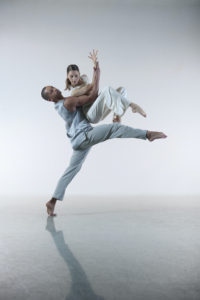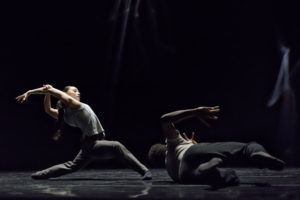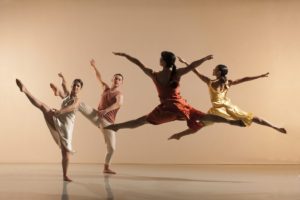London, February/March 2020 - Vancouver Ballet Society
- Home
- City Reports 2020 - 2023
- London, February/March 2020

By Sanjoy Roy
The farewell performances by Richard Alston Dance Company, at Sadler’s Wells Theatre in March, marked the end of a singular line in British dance. Alston, now 71, was a founding figure of modern dance in the UK. In the first intake of students at the newly formed London Contemporary Dance School in 1967, he went on to found the pioneering if short-lived Strider in 1972, and was later artistic director of Rambert Dance Company from 1986 to 1992, and of his own eponymous group from 1994.

Though his career spans an era in the history of British dance, Alston has swum in his own slipstream, at one remove from changing trends and tugs. His abiding interest has been in the musicality of dance — which is not the same as dancing to music (though music is usually his inspiration), but rather a concern with the textures, dynamics, phrasing and composition of movement. In the process, he has developed a signature style that blends the spatial articulation of Merce Cunningham and the graceful expressivity of Frederick Ashton with the breath and weight of release techniques.
In fact, Alston often seems “at one remove” from things, and not just the wayward currents of contemporary dance. In a characteristically self-effacing gesture, he decided to disband the company not through choice, but because he felt that The Place (the umbrella organization where his company was based) would have its funding cut if he didn’t.

That self-effacement (or modesty, reserve, generosity, call it what you will) was also evident in this program. It opened with a piece not for his company, but for students of London Contemporary Dance School: Bari, a breezily upbeat work based on Italian folk rhythms. And it gave a prominent place to a new commission by Martin Lawrance, a one-time Alston dancer who he has backed as a choreographer — and with good reason, on the evidence of A Far Cry. The drives, gusts and vortices of its choreography showed Lawrance as influenced by his senior but with a nervy dynamism all his own.
What of Alston’s own qualities? Music — preferably live — evidently had pride of place: each of his works presented here was set in a distinct sonic world. I’ve often found Alston most bracing when he takes on “difficult” contemporary music, without the stable foundations of regular metres or harmonies. So it was with the razor-sharp Isthmus from 2012, to a score by Jo Kondo, the fractures and dissonances of the dancers’ phrases somehow made to fit together like a fiendish puzzle.
If Isthmus showcased Alston’s compositional dexterity, both Shine On (to a Britten song cycle) and Voices and Light Footsteps (to Monteverdi) moved into a more human yet also more reserved world: mind and heart always present, but subsumed by grace and good manners. Still, just as the famous English reserve can never quite succeed in effacing the vagaries of feeling and character, so Alston’s choreography intermittently unmasked moments of tenderness, fatigue or joy. That was especially evident in the 2015 Mazur, a male duet to Chopin mazurkas (played by pianist Jason Ridgway, a frequent collaborator), its surface of gentlemanly courtesy ruffled by subtler undercurrents of longing, conviviality, isolation or resolve.
Sensing Alston’s own sensitivities requires a degree of attentiveness from us, for he is too well-mannered to signal them outright. Like Chopin, too easily dismissed as salon music for polite society, the incontestably good taste of Alston’s choreography may cover yet cannot conceal a subtler interior world. Chopin’s scores, of course, are recorded and replayed; Alston’s work may now no longer have that opportunity.
That is the story of so much modern dance: created, performed, lost. Earlier, over at the Barbican Centre, former Royal Ballet principal Viviana Durante directed an evening of dance in response to this very fate, staging three contrasting “afterlives” given to one of modern dance’s founding mothers, Isadora Duncan: a reconstruction (Duncan’s Dance of the Furies), an homage (Ashton’s 1975 solo Five Brahms Waltzes in the Manner of Isadora Duncan) and a creative reimagining (Unda, a new ensemble piece by Joy Alpuerto Ritter). It made for an interesting but oddly unsatisfying evening, the central Five Brahms Waltzes holding their own, with the fierce opening dance mostly of historical interest and the final, oversaturated work eventually drowning in rather than riding upon its own imagery.

Revisor, the third joint venture by Crystal Pite and Jonathon Young, could also have been something of an information overload. Certainly its source material — Nikolai Gogol’s 1836 play The Inspector General — with its story of mistaken identity, petty bureaucracy and wilful deception, was a lot to take in; and the sudden turn in the middle of the piece, which replays the scenes in less narrative, more choreographic terms, was wilfully disorienting. But it’s an endlessly fascinating work, that (having watched it twice) I took in two different ways. To focus on the medium was to see how finely it synced its elements — movement, voice, text and lighting in particular — and how cannily it deployed their dissociation. To focus on its meanings was to sense how a kind of normality could split open to reveal a Lynchian underworld of dark fantasies, repressions and paranoia. Both approaches were immensely rewarding.

